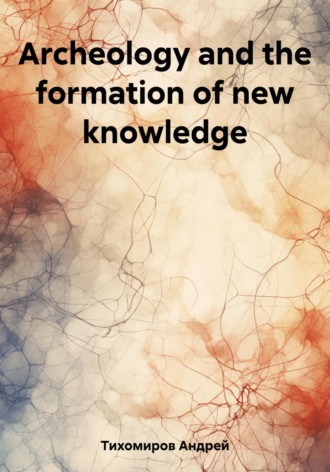
Андрей Тихомиров
Archeology and the formation of new knowledge
The significance of archaeology
Charles Darwin (1809-1882) was right when he asserted his theory, which received the name Darwinism from his surname. In his main work "The Origin of species by natural selection" (1859), summarizing the results of his own observations (sailing on the Beagle, 1831-1836) and the achievements of modern biology and breeding practice, he revealed the main factors of the evolution of the organic world. In the work "Changing domestic animals and cultivated plants" (vol. 1-2, 1868), he outlined additional factual material to the main work. In the book "The Origin of Man and sexual selection" (1871), he substantiated the hypothesis of the origin of man from an ape-like ancestor.
The driving forces of evolution, according to Darwin, are hereditary variability and natural selection. Variability serves as the basis for the formation of new signs in the structure and functions of organisms, and heredity fixes these signs. As a result of the struggle for existence, there is a predominant survival and participation in the reproduction of the fittest individuals, that is, natural selection, the consequence of which is the emergence of new species. At the same time, it is essential that the fitness of organisms to the environment is relative. Independently of Darwin, A. Wallace came to similar conclusions. A significant contribution to the promotion and development of Darwinism was made by T. Huxley (in 1860 he proposed the term "Darwinism"), F. Muller and E. Haeckel, A. O. and V. O. Kovalevsky, N. A. and A. N. Severtsov, I. I. Mechnikov, K. A., Timiryazev, I. I. Schmalhausen, etc. In the 20-30s of the 20th century, the so-called synthetic theory of evolution was formed, combining classical Darwinism and the achievements of genetics. As a holistic materialistic doctrine, Darwinism actually revolutionized biology, undermined the positions of creationism and vitalism, and had a huge impact on natural and social sciences and culture in general in the 2nd half of the 19th century. However, during Darwin's lifetime, along with the widespread acceptance of his theory, various currents of anti-Darwinism arose in biology, denying or sharply limiting the role of natural selection in evolution and putting forward other factors as the main forces leading to speciation. The controversy over the main problems of Darwin's evolutionary teaching continues in modern science, although Darwin's theory is being proved more and more. For example, in archaeology, a science that studies the history of society based on the material remains of people's lives and activities – material monuments. Archaeology explores individual ancient objects (tools, vessels, weapons, jewelry) and entire complexes (settlements, treasures, burial grounds) discovered by archaeological excavations, on the basis of which historians reconstruct the history of epochs that are little or not covered by written sources, including the stages of the formation of ancient man.
Some stages of the study of ancient hominids based on archaeological finds
August 1891. Java Island (at that time Dutch India, now Indonesia). A young Dutch doctor Eugene Dubois found a molar tooth resembling a chimpanzee tooth in volcanic layers on the bank of a mountain river, and a little later – a strange cranial lid: the forehead is very sloping, a fairly large volume of the brain box, a large supraorbital roller. The following year, Dubois found a thigh resembling a human thigh, and a tooth – the same as the first, only chewing. Already in our time, it has been proved that both the femur and the turnip box found at that time by Dubois belonged to the same creature. Moreover, the combination of a primitive skull and relatively progressive bone development is precisely the characteristic feature of fossil humans. The findings made by Dubois provided the supporters of the evolutionary theory with convincing evidence of the validity of their views. Before the scientists were the remains of ape-men who lived 600-700 thousand years ago. Nature has revealed one of its "secrets" and confirmed the correctness of the theoretical views of the supporters of the evolutionary doctrine.
Other finds followed. In China, in a wide cleft of the hill of the Dragon Mountains, in December 1929, the first specimen of the so-called synanthropus was found. In its appearance, the skull resembled the skull of a pithecanthropus found by Dubois, although it seemed a little more "civilized". Scientists also discovered tools of the synanthropes: some of the earliest – roughly processed, with a wide oval blade, made of sandstone, quartz, quartzite; and in many flakes and bones, they were used as cutting tools. Already at the very beginning, most researchers believed that synanthropes were akin to pithecanthropus, in any case, they were somewhere close to them. It is now recognized that both are pithecanthropus. Found in Java – Javanese, in China – Beijing.
Near the city of Heidelberg, in Germany, archaeologists have found the jaw of a primitive man. And although the teeth of the Heidelberg man were more similar to human teeth than those of a synanthrope and a pithecanthropus, it is obviously most correct to classify him as a pithecanthropus too.
The remains of pithecanthropus were found in Eurasia, Africa. They were still very primitive, these people. And they had to undergo many changes in order to get closer to modern man. But they were already different from monkeys, even the most highly developed: they had free hands and walked straight on the ground. Let it not be as straight as modern people, but without getting on all fours like monkeys.
By the 20s of the last century, none of the scientists doubted that nature took a long time to create this amazing creature – man. Until a certain time, purely biological factors played a decisive role in its formation. But it was with the conscious and necessary use of tools for life, with the manufacture of tools, even the most primitive, that a fundamentally new segment of the path began, which led our ape-like ancestor to the heights of modern culture.
Science has established that, in addition to the most ancient people – pithecanthropus, in times closer to us, the earth was inhabited by so-called Neanderthals. Back in 1856, in Germany, in the Neanderthal Valley, a skull cap with a massive supraorbital roller and a low cranial vault and the upper part of the femur were found. Controversy immediately erupted around this find. And it did not seem very true that these bones belong to some ancient human race. But then scientists became convinced of this.
Neanderthal remains have been found in Eurasia and Africa.
Stocky, stooped, with very strong arms and short legs, the so-called "classic" Neanderthal used fire, knew the value of tools and weapons, perfected them.
About 40-50 thousand years ago, the earth was inhabited by Cro-Magnons and Grimaldians, people of the modern type. The monkey features disappeared. The creation of the most complex and most delicate nervous system in the animal world has been completed. Different parts of the cerebral cortex have united into a single functional system. Cro-Magnons and Grimaldians had a human type of thinking and, accordingly, human speech. These first modern people had straight legs, a fairly straight spine, and the face of a modern person. The brain was practically no different from the modern one.
Found back in 1924 in South Africa, Australopithecines have already passed the main milestone on the path of their evolution about 5 million years ago: they moved more or less freely on their feet. True, Australopithecines were not our direct ancestors. Now there are several species of Australopithecus, of which the most progressive is the so—called Zinjanthropus, who lived a million and a half years ago on the territory of modern Tanzania (East Africa). And there, in 1960, the first skull of a creature that lived 250-300 thousand years before the zinjanthropus was found and therefore called the prezinjanthropus. This creature, according to most scientists, was already a man!







